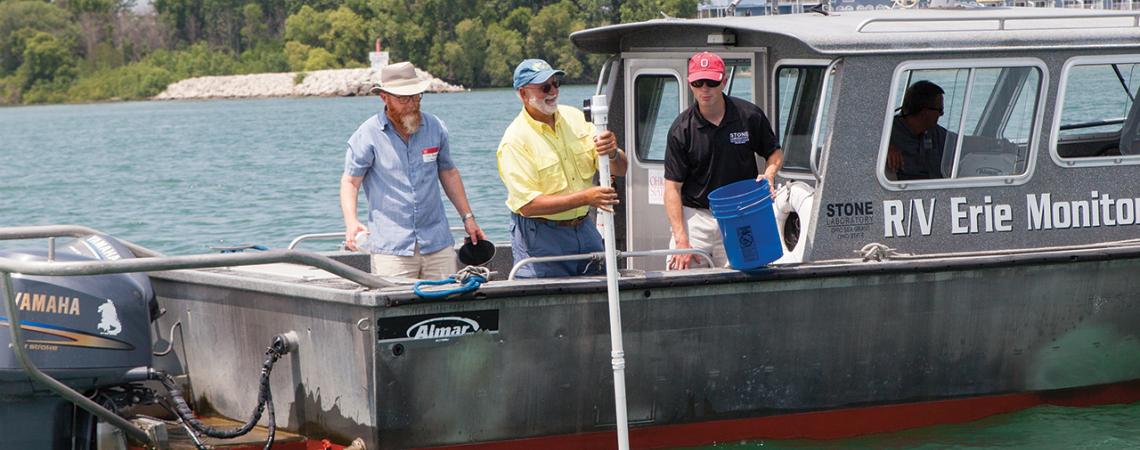Charter captain Dave Spangler (in yellow) practices a little citizen science aboard a Stone Lab vessel near Middle Bass Island.
It’s no secret that Lake Erie’s recent algae blooms have a small army of scientists and conservationists working nonstop to remedy its troubles. But a little-known faction has been feeding valuable data to those problem-solvers: charter captains.
“We first started with the Ohio EPA,” says Dave Spangler, longtime captain and vice president of the Lake Erie Charter Boat Association (LECBA). The EPA, he says, sent lab technicians wading near shore to collect samples. “The better part of the Western Basin just wasn’t getting covered,” he says.
“We’re all out there every day already, so why not (make use of us)?”
Now, more than a dozen captains provide a steady season-long stream of info to scientists. “We give the exact location we were when we sampled and offer the water temperature, depth, clarity, and also wind conditions and anything else that’s happening at the time,” Spangler says.
Algae blooms, which can create harmful toxins in the water, have been around for years, but gained notoriety in 2014, when a massive bloom caused Toledo’s drinking water to become unusable for three days. The Toledo water crisis made international news — and it was terrible for tourism, including the fishing business. Captains’ work as scientists has been expanding ever since.
“During the past two seasons, we’ve been sport fishing out on the lake with Ohio Division of Wildlife, and we implant walleye with radio telemetry transmitters,” says Paul Pacholski, LECBA president. Pacholski works nearly full time on education, public relations, and data collecting for the group. “We’ve recently worked with Wayne State University on an invasive species study and Heidelberg University on a Maumee River water flow study,” he says.
In fact, Pacholski says he and other charter captains have worked with just about every university in the region on not only Lake Erie-related research projects, but also inland marshes and estuaries.
When asked if charter captains weren’t supposed to be out on the lake during the algae crisis, Pacholski laughs. “My mom wrote me a note that said I can go anywhere I want,” he brags.
Justin Chaffin, research coordinator at Stone Lab, Ohio State University’s island science spot (situated on tiny Gibraltar Island at Put-in-Bay), says the partnership works well. “We train the captains to collect the samples, but also to talk about the data and issues with their customers, and that translates into a really great outreach project.”
Chaffin says info from charter captains gets compared to bona fide, professional data — and it’s solid. “It’s surprising how accurate the charter captain data set is,” he says. “The added benefit is they have opportunity to talk with the public about all the issues and disseminate accurate information.”
Captains have their fishy fingers into more than just algae blooms and radio telemetry. Another Stone Lab study determines how water turbidity and algae affect the vision of both walleye and their favorite food, emerald shiners.
“We’re learning some really cool things about which lure colors that walleye prefer under different conditions,” says Suzanne Gray, assistant professor of aquatic physiological ecology at Ohio State. Spoiler alert: “When there’s an algae bloom, I believe having black components in the lure is beneficial,” she says. While Gray and staff have been working with fish in the laboratory, captains are doing the same on the lake via a cellphone app developed by graduate student Chelsey Nieman. The app allows captains to capture and send on-the-water data — and photos — back to Stone Lab.
The photos provide information as detailed as a fish’s eye size, exact location of a catch, and an image of water at the site, all of which is meshed with satellite imagery and info from scientific buoys and weather stations.
“They have a vinyl sheet with a ruler on it,” Gray says. “There’s a color wheel and a place to put the lure that caught the fish. They place fish on the ruler, the lure in the box, and take a photo off the side of the boat. Some of the charter captains love to email Chelsey with their stories. I think it’s great.”
This summer, Gray, staff, and students will fish with captains in controlled angling studies. “So far, they’re only telling us what’s successful, not all the lures they switched out, all the ones that didn’t catch fish. This is the first time I’ve tapped into the expertise of people who are actually out there, the ones on the water. They know the lake and they know the fish, and that’s been truly awesome.”
James Proffitt is a freelance writer from Marblehead.









